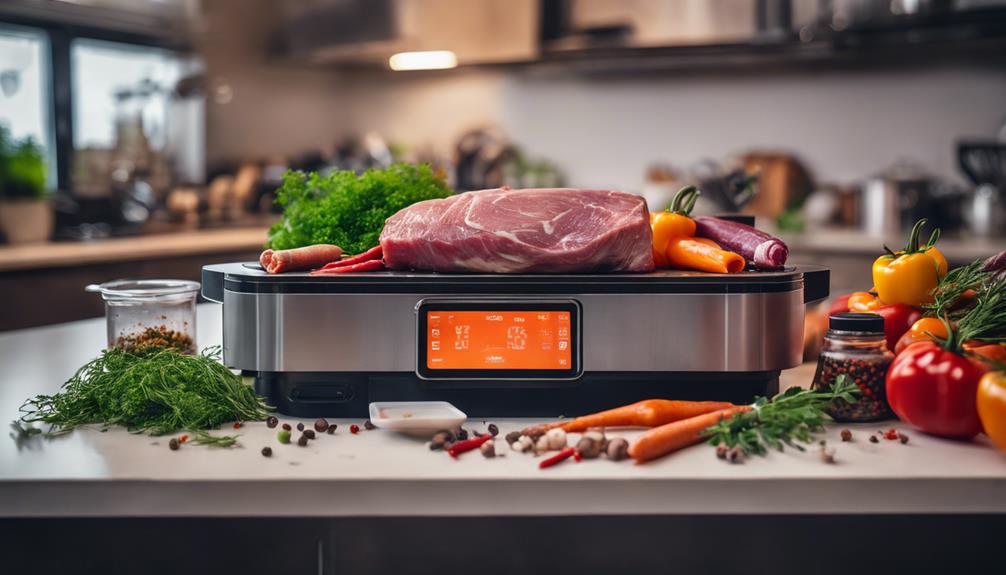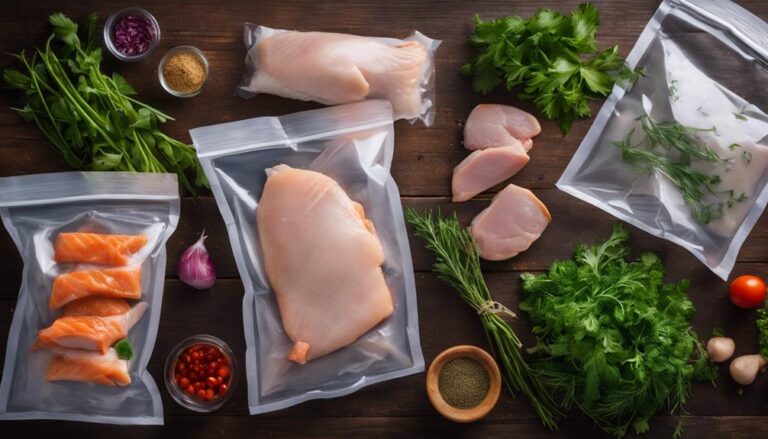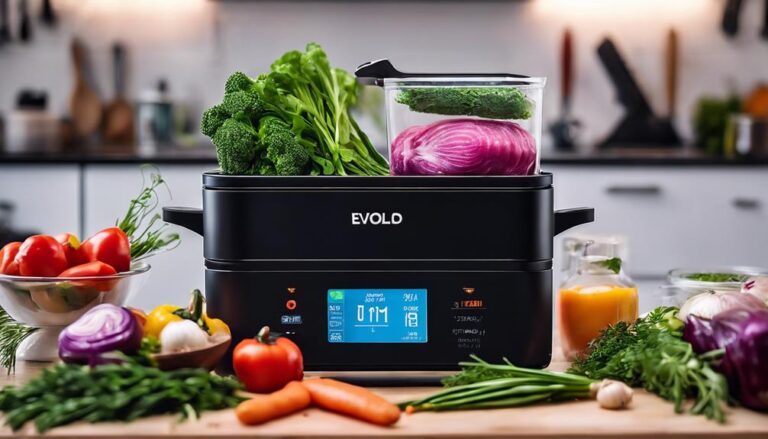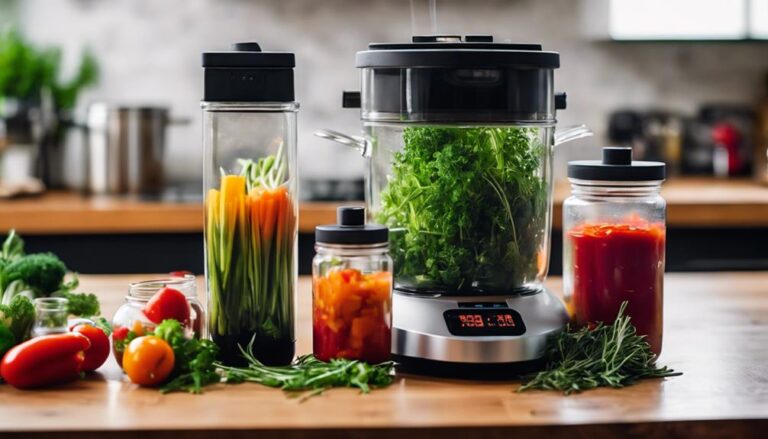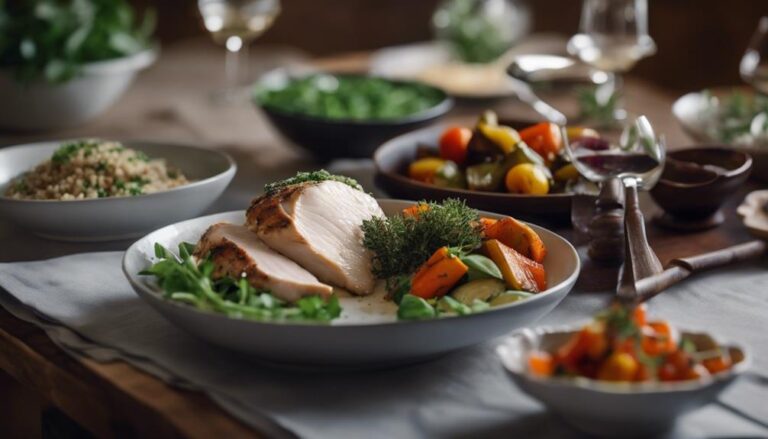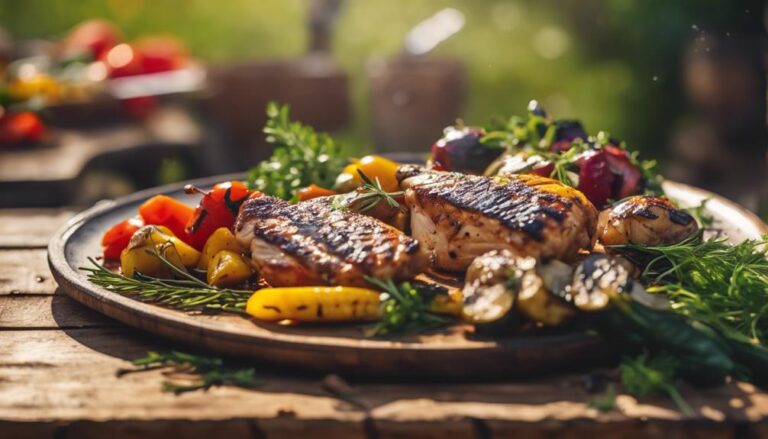Fat Reduction: Cooking Without Added Oils Using Sous Vide
Cooking without added oils using sous vide is an effective way to reduce fat in your meals. This method can cut fat content by 80-85% while preserving flavor and nutrients. By vacuum-sealing food, you retain moisture and enhance natural tastes without the need for extra fats. You can further boost flavor using herbs and spices, allowing for delicious, low-calorie dishes. Consider trimming excess fat from meats and using lean cuts for healthier options. Sous vide lets you control cooking temperatures precisely, helping you achieve tender results. Discovering more about this technique can enhance your culinary experience.
What You Will Learn Here
- Sous vide cooking reduces fat content by 80-85% while enhancing natural flavors through precise temperature control and moisture retention.
- Vacuum-sealing food with herbs and spices infuses flavors without the need for added oils or fats.
- Trimming excess fat from meats and using lean cuts promotes healthier meals while preserving taste.
- Cooking purge can be utilized to create rich sauces, maximizing flavor retention without additional fats.
Benefits of Cooking Without Oils
Why should you consider cooking without added oils? It offers a range of health benefits that can transform your meals.
Cooking without oils, especially using the sous vide method, considerably reduces fat content, with studies showing up to 80-85% less fat in your meals. This leads to healthier options that still taste great. By sealing in moisture and nutrients, sous vide enhances the natural flavors of food, allowing you to enjoy rich, flavorful dishes without relying on extra fats.
Eliminating oils also helps lower your overall caloric intake, which can contribute to healthier eating habits and potentially lower cholesterol levels. Plus, sous vide cooking minimizes nutrient loss that often occurs with traditional methods. The vacuum-sealing technique preserves vitamins and minerals, ensuring you get the most out of your ingredients.
Additionally, cooking without added oils supports healthier grab-and-go options, making it easier for you to choose nutritious meals that fit your busy lifestyle.
With all these benefits, cooking without oils not only promotes better health but also encourages you to explore innovative culinary possibilities that prioritize taste and nutrition.
Sous Vide Vs. Traditional Methods
Sous vide cooking stands out from traditional methods by allowing you to create low-fat meals without sacrificing flavor or moisture. Unlike conventional techniques that often rely on added oils for taste, sous vide harnesses the natural fats found in meats and proteins. This innovative approach can lead to a significant reduction in overall fat content, even cutting it by up to 80-85% in foods like bacon.
Another key advantage of sous vide is its ability to retain moisture and tenderness. In traditional cooking, overcooking can easily lead to dried-out meals, while sous vide guarantees your food remains juicy and flavorful.
The vacuum-sealing process also minimizes air exposure and oxidation, preserving essential nutrients that might otherwise be lost through methods like boiling or steaming.
Enhancing Flavor With Seasonings
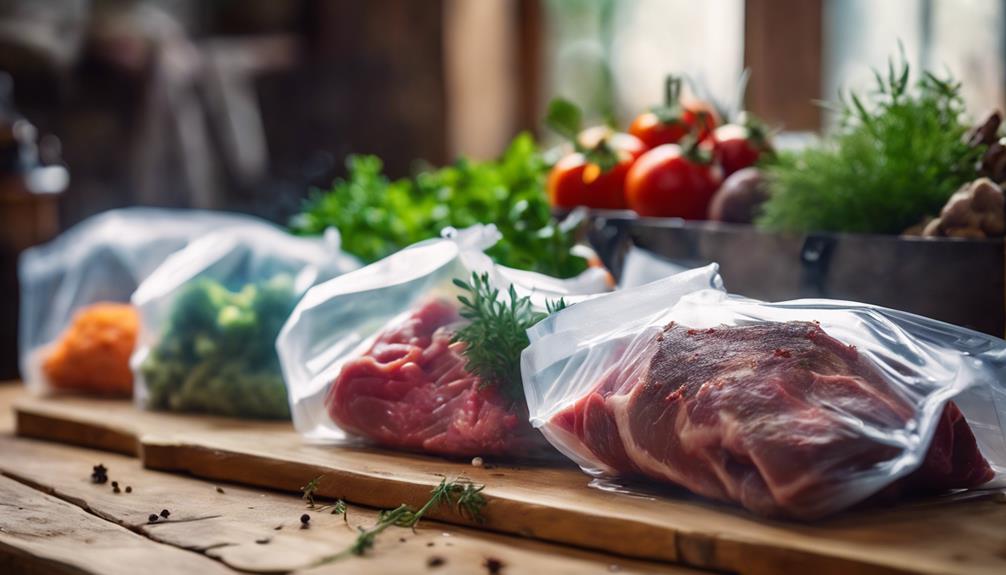
Enhancing the flavor of your sous vide meals is easily achieved by incorporating herbs and spices directly into the vacuum-sealing bags. By doing this, you infuse your ingredients with incredible taste without the need for adding fat. Popular choices like garlic, thyme, or cumin can elevate your dishes, allowing the natural flavors to meld during the cooking process.
Experimenting with various seasonings opens up a world of culinary possibilities. You can explore unique flavor profiles, such as Moroccan spices or Thai ingredients, while keeping your meals low in calories. Seasoning right before searing can also maximize flavor retention, ensuring that the essence of your ingredients shines through without interference from added fats.
Don't overlook the cooking purge, which is the meat essence released during sous vide. This flavorful liquid can be transformed into sauces and reductions, enhancing your meal further while avoiding unnecessary saltiness.
Creative Flavor Combinations
Building on the idea of using seasonings, creative flavor combinations can transform your sous vide dishes into culinary masterpieces without the need for added oils. By infusing flavors during the sous vide cooking process, you allow the natural tastes to shine through, enhancing each dish.
Here are four innovative flavor combinations to try:
- Garlic, Thyme, and Red Wine: Perfect for casseroles, this trio adds depth and richness to your meals.
- Ginger, Garlic, and Cumin: Ideal for curry dishes, these spices create a warming, aromatic experience.
- Lemongrass and Fish Sauce: This combination brings a bright, tangy flavor to your Thai-inspired recipes.
- Lime and Chili: Embrace bold Mexican flavors with this zesty pairing that adds a kick to any dish.
Experimenting with spice rubs or adding fresh herbs to your vacuum-sealed bags allows you to create unique flavor profiles tailored to your preferences.
Additionally, utilizing the cooking purge from the meat in sauces can enhance the overall dish flavor while retaining nutrients.
With these creative flavor combinations, your sous vide meals can be both delicious and healthy.
Understanding Sous Vide Basics

Precision in cooking is key, and sous vide offers a reliable method for achieving perfectly cooked meals every time. This innovative technique involves sealing food in a vacuum-sealed bag and submerging it in water at precise temperatures. With sous vide cooking, you can prepare meats, vegetables, and eggs while retaining their natural moisture and enhancing flavors without using added oils or fats.
The beauty of sous vide lies in its ability to deliver consistent results. Different foods require specific cooking times and temperatures, especially meats, which are usually cooked at lower temperatures for longer durations to reach the desired doneness. By vacuum-sealing your ingredients, you minimize air exposure, preventing oxidation and moisture loss. This process helps preserve the food's natural taste and nutritional value.
Moreover, sous vide cooking can greatly reduce fat content in your meals. For instance, bacon cooked using this method can lose up to 80-85% of its fat while still maintaining its rich flavor and texture. This makes sous vide an ideal choice for those seeking healthier cooking options without sacrificing taste or quality.
Embrace sous vide cooking to elevate your culinary experience.
The Role of Fats in Cooking
Why do fats play such an essential role in traditional cooking methods, and how can sous vide change that dynamic? Fats, like butter and oils, enhance flavor and prevent burning, but sous vide cooking redefines this approach. With precise temperature control, you can achieve delicious results without the added fat, paving the way for healthier meals.
Here are four key points to reflect on:
- Flavor Retention: The vacuum-sealing process minimizes air exposure, helping to lock in moisture and natural flavors, making added fats less necessary.
- Reduced Fat Content: Sous vide cooking can cut fat content by up to 80-85%, allowing you to enjoy lower-calorie meals while maintaining flavor and texture.
- Alternative Flavor Enhancers: Using herbs and spices during sous vide can enhance your dishes without relying on fats. You can still enjoy vibrant flavors without adding butter or oil.
- Thermal Efficiency: While certain oils improve thermal transfer, many chefs find that sous vide yields satisfying results without them, challenging traditional cooking norms.
Strategies for Fat Reduction
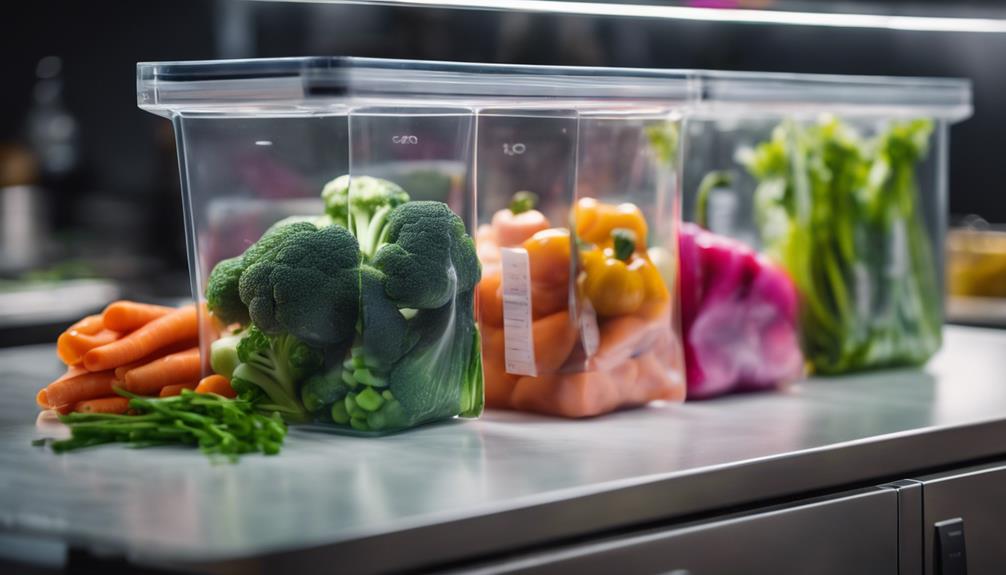
Trimming excess fat from meats before sous vide cooking can greatly enhance your dishes' healthiness without sacrificing flavor. This simple step not only reduces the fat content but also allows the natural flavors of the meat to shine through.
If you're cooking bacon, try sous vide at 145°F (63°C) for 24-30 hours; this method can render fat effectively, cutting down fat content by 80-85%.
You might also explore cooking techniques like starting with water or using a sheet pan to promote fat rendering during the sous vide process. If you're looking for healthier bacon options, consider alternatives such as back bacon or cottage bacon, which provide delicious flavors with lower fat content.
Additionally, don't forget about the small steps that can make a big impact. After cooking, simply drying your bacon with paper towels or placing it on bread can help soak up excess grease.
You'll find that these strategies can reduce the need to add additional fats while still delivering satisfying meals. By implementing these techniques, you can enjoy flavorful dishes while maintaining a focus on health and innovation.
Exploring Alternative Ingredients
When you're cooking sous vide, exploring alternative ingredients can make a big difference in flavor and nutrition.
You can replace added oils with fresh herbs, spices, and moisture-rich vegetables to enhance your dishes without extra calories.
Choosing lean cuts of meat or using flavorful broths can also elevate your meals while keeping them healthy.
Healthier Ingredient Choices
Exploring healthier ingredient choices in sous vide cooking lets you enjoy flavorful meals while keeping fat content in check. By focusing on what you use, you can achieve significant fat reduction without compromising taste.
Here are some innovative ideas to elevate your meals:
- Lean Cuts: Opt for leaner cuts of meat, like back or cottage bacon, to minimize fat while still enjoying rich flavors.
- Trim the Fat: Before cooking, trim excess fat from meats. This simple step can drastically lower overall fat content in your dishes.
- Herbs and Spices: Enhance your meals using herbs, spices, and natural flavorings. These ingredients boost flavor without the need for added oils or fats.
- Vegetable-Based Broths: Experiment with vegetable-based broths or marinades. They infuse delicious flavors while keeping fat content low.
Flavorful Seasoning Alternatives
Building on healthier ingredient choices, incorporating flavorful seasoning alternatives can elevate your sous vide dishes without the need for added oils.
By using a variety of herbs and spices, you can enhance the flavor profile of your meals while keeping them low in fat. For instance, blending Moroccan spices like garlic, ginger, and cumin can infuse your meats with incredible depth. Alternatively, try Thai-inspired ingredients such as chili and lemongrass for a vibrant twist.
Another innovative approach involves utilizing the cooking purge—the essence released from meats during sous vide—as a base for sauces and reductions. This method allows you to achieve rich flavors without extra fats.
Additionally, consider seasoning your meat right before searing; blind taste tests suggest this technique retains more flavor compared to pre-seasoning.
Community Insights and Experiences

When you cook using sous vide, you can explore various personal techniques that enhance flavor without added oils.
Many community members experiment with different seasonings and flavor combinations, often sharing their successes in online discussions.
These insights can inspire you to try trimming excess fat and focusing on the natural tastes of your ingredients, leading to healthier and delicious meals.
Personal Cooking Techniques
Many home cooks share their success stories of enhancing flavor while cutting out added oils in sous vide cooking by harnessing the natural fats and juices of their ingredients. You can achieve flavorful results without compromising health by exploring these innovative techniques:
- Trim Excess Fat: Before cooking, trim any unnecessary fat from your meats. This helps reduce the overall fat content while still allowing the meat's natural flavors to shine.
- Season Before Searing: By adding your herbs and spices just before searing, you can lock in flavors, creating a more satisfying dish without needing additional fats.
- Experiment with Herbs: Incorporate bold herbs, like garlic and thyme, or even a splash of red wine. These additions can elevate the taste profile considerably without adding oils.
- Utilize Natural Juices: Embrace the natural fats present in your ingredients. Using sous vide allows these juices to concentrate, enhancing flavor while keeping your meal healthier.
Flavor Experimentation Practices
Flavor exploration in the sous vide community reveals exciting insights and innovative practices that enhance dishes without added oils. Many cooks emphasize the importance of seasoning just before searing, which helps retain flavors and provides a more pronounced taste experience.
By experimenting with various herbs and spices, like garlic and thyme for casseroles or cumin and coriander for curry, you can greatly elevate your dishes without adding fats.
Community members often conduct blind taste tests, showing little to no difference between sous vide dishes cooked with and without oils. This promotes a preference for the natural flavors of the ingredients.
Additionally, some enthusiasts suggest using cooking purge, or meat essence, in sauces and reductions to harness the concentrated flavors released during cooking.
Engaging in discussions and sharing experiences with fellow cooks can lead to discovering unique flavor combinations and techniques. These flavor experimentation practices encourage you to continually explore oil-free sous vide cooking, allowing your culinary creativity to flourish.
Experimentation in Cooking Techniques
Experimenting with sous vide techniques opens up a world of culinary possibilities, allowing you to enhance the natural tastes of your ingredients without relying on added oils. This innovative cooking method encourages you to explore various flavor profiles while promoting healthier meal options.
Here are a few ways to elevate your sous vide experience:
- Infusion Techniques: Use herb sprigs or spice rubs in vacuum-sealed bags to infuse bold flavors during cooking.
- Salted Ingredients: Try cooking with just salt, as studies show this can yield more flavor than traditional methods using butter.
- Temperature and Time: Experiment with cooking times and temperatures to achieve ideal moisture retention and flavor development tailored to your preferences.
- Community Engagement: Participate in discussions and blind taste tests with fellow sous vide enthusiasts to refine your techniques and identify your flavor preferences.
Frequently Asked Questions
Can You Sous Vide Without Oil?
Absolutely, you can sous vide without oil! By vacuum-sealing your ingredients, you enhance flavors and retain moisture naturally. Experiment with herbs and spices to elevate your dishes while keeping them healthy and delicious.
How Do You Cut the Fat in Sous Vide Steak?
To cut the fat in sous vide steak, trim excess fat before cooking. Choose lean cuts, cook at lower temperatures, and sear afterward for a flavorful crust—innovatively enhancing taste while keeping the fat content low.
What Happens to Fat in Sous Vide?
When you cook sous vide, fat gently renders while flavors intensify. The precise temperature control allows the meat to retain its natural moisture, creating a deliciously tender dish without needing extra oils or unhealthy additives.
Do You Put Butter or Oil in Sous Vide Steak?
You don't need to add butter or oil when cooking steak sous vide. The vacuum-sealing technique locks in moisture and flavor, allowing you to enjoy tender, delicious meat with just the right seasoning.
Conclusion
To sum up, cooking without added oils using sous vide offers a healthy and flavorful way to prepare meals.
By understanding the basics of sous vide and exploring various seasonings and alternative ingredients, you can enhance the taste of your dishes while reducing fat.
Embracing these techniques not only promotes better health but also encourages creativity in the kitchen.
With practice and experimentation, you can discover new and exciting flavors that make your meals enjoyable and nutritious.
